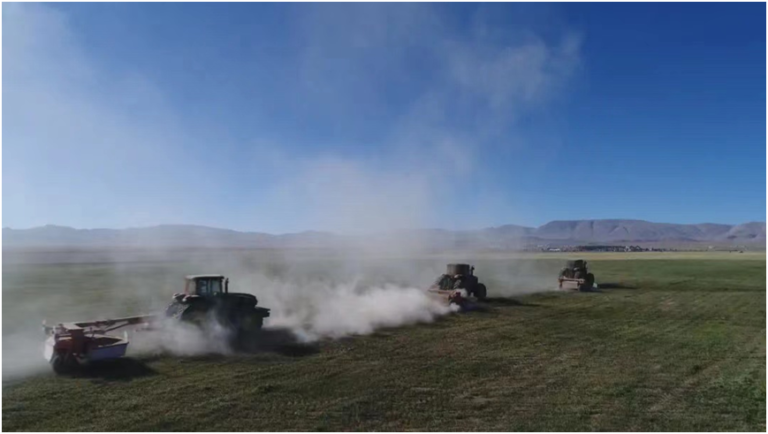
By ChungdaDrolkar, People’s Daily
In recent years, southwest China’s Tibet autonomous region has promoted forage grass planting projects across the region to alleviate problems threatening grassland ecological security caused by the conflict between grassland ecology and livestock farming.
Located in a high-altitude cold area, Tibet boasts vast expanses of natural grassland. Grassland animal husbandry is a basic industry on which local farmers and herdsmen reply for survival and development.
Due to long-term overgrazing as well as factors including high altitude, cold climate, and drought, grassland in Tibet had low yield and recovered slowly from degradation in the past. A lot of grasslands in some parts of the region suffered from varying degrees of degradation and saw their ecological functions weakened and productivity reduced.
Grass planting projects in the region have accelerated the transformation and upgrading of the local animal husbandry industry, achieving good ecological and economic benefits while easing the environmental pressure on grassland resources.
Nagqu city of Tibet is a major producing area of livestock in the region. Although the city has a large area of grassland, it sits at a high elevation and its ecological environment is quite fragile.
In an effort to improve the situation, the municipal government of Nagqu has made continuous efforts to encourage the introduction of high-quality forage grass species and varieties suitable for alpine and cold pastoral areas.
Over the past more than 10 years, Nagqu has introduced more than 100 varieties of forage grass from both inside and outside Tibet and selected 19 varieties suitable for different areas of the city. In 2021, it promoted the planting of high-quality and high-yielding oat grass varietieson more than 50,000 mu (about 3,333 hectares) of contiguous land and the planting of 46,000 mu of forage grass around people’s homes.
“I didn’t expect to succeed in planting grass at such a high altitude. Oats here have an average plant height of 1.5 meters, with some reaching as high as 1.7 meters,” said Yan Jun, a technicianwith Nagqu grassland station.
According to Yan, last year, the grassland stationcreated a grass planting model featuring full mechanization and regionalization in Nyima county ofNagqu city, speeding up the transformation and upgrading of grassland animal husbandry and grassland restoration of the city..
In Nyerutod township, Kangmarcounty, Shigatse city of Tibet, workers are busy growing forage grass at a planting base covering an area of 10,000 mu.
“We will continue planting alfalfa, oat grass, and green wheatgrass this year,” said Karma Tendar, mayor of Nyerutodtownship.
During the past six years, the township has created 23,000 mu of grass planting bases and developed the sheep farming industry and grass pellet production line that are closely related to them, said the town mayor.
Li Xin, manager of a local forage grass planting cooperative, told People’s Daily that the cooperative plans to increase the added value of forage grass by making full use of green hay to produce pellet feed.
“Not only are our sheep and cattle well fed, but our village becomes more beautiful,” said a 66-year-old villager namedLhundrup, who is gratified by the good changes brought by grass planting projects.
So far, the total area of lands reserved for planting grass across Tibet has reached 1.57 million mu. To scientifically evaluate the results of those grass planting efforts, the remote sensing application research center of Tibet has selected 153 typical plots from 1,066 planted grasslands in the region to carry out monitoring, analysis, and evaluation with the help of high-precision remote-sensing image data. As the results showed, most of the planted grasslands grow much better than natural ones.
Tibet is currently troubled by environmental problems such as grassland degradation, sandification, and desertification. Planted grasslands provide clear benefits over natural ones in grass yield and quality, resistance to natural disturbance, regional water and soil conservation, and ensuring stable resources of forage grass.
Research showed that the surface runoff and erosion of lands with turf are 47 percent and 77 percent less compared to those without turf.
Planted grass grows fast, and large-scale planting can effectively reduce combat wind erosion and soil sandification.
“Planted grasslands allow natural ones to be rehabilitated and play prominent roles in guaranteeing the production and quality of forage grass, resisting natural disturbance, and regional water and soil conservation,” said Bian Duo, head of the remote sensing application research center of Tibet.
The center is going to intensify efforts to monitor planted grasslands by leveraging remote-sensing technology, according to Bian.
“We will conduct evaluations of climate suitability before grass is planted so as to avoid irrational decision-making and make sure grass is planted according to needs and that every plant generates expected ecological and economic benefits,”Bian added.










